Ledebouria venteri
Ledebouria venteri Van Jaarsv. & A.E.van Wyk
Family: Hyacinthaceae
Common names: Gouritz cliff squill, Venter’s African hyacinth (Eng.); Gouritz krans-slangkop (Afr.)
Introduction
Ledebouria venteri is a cluster forming bulbous plant with pale green, uniformly coloured leaves in an apical rosette and a spreading inflorescence of small purplish flowers, only known from cliffs along the banks of the Gouritz River in the Western Cape, the bulbs growing above the substrate. Best grown in containers.
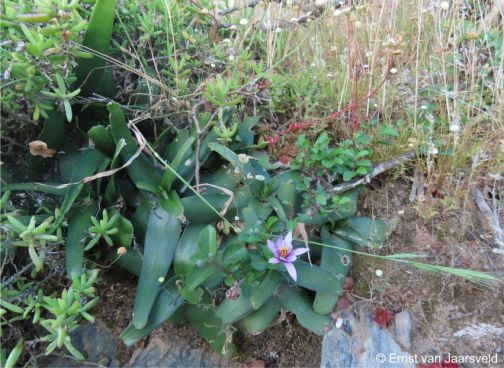
Fig. 1. Ledebouria venteri in habitat on a shale cliff on a farm along the Gouritz River, Western Cape, growing with Grewia occidentalis.
Description
Description
Plants bulbous, at first solitary, proliferating and forming clusters up to 220 mm in diameter containing up to 14 individuals. The bulbs usually grow exposed above the crevice or substrate level. The bulb rounded, up to 50 × 45 mm, each bulb covered in dense, dry, thin tunic remains; dry bulb scales (tunics) thin, papery, brownish, transparent, with indistinct, transverse abscission layer. The roots are fleshy, up to 1.5 mm long. Leaves succulent, 6–12, spreading, linearly spear-shaped (lanceolate) to broadly spear-shaped (ovate-lanceolate), 55–100 × 15–35 mm, green, without hairs (glabrous), faintly striped (obscurely striate), with thread-like strings when severed; lower surface with purplish streaks in centre and towards base, the leaf tip ending in a sharp point, becoming slightly channelled. The leaf base is enlarged and circles the stem (amplexicaul), the margin white, with minute teeth (denticulate). The inflorescence is 70–100 mm long, the stalk rounded (terete), 50 mm long, 3 mm in diameter at base, the raceme 40–50 mm long, with up to 14 flowers open at the same time, the main floral stem (rachis) angular. Each flower with a small, linear bract tapering to a point (subulate), curving upwards, 1 × 0.3 mm. The flowers spreading, nodding, the stalks 14–15 mm long, maroon-mottled. The floral tepals triangular-ovate, 5 × 1.5 mm, purplish green, soon becoming reflexed, each tepal pointed. The stamens 3.0–3.5 mm long, purplish, base green and the anthers 0.75 mm long with yellowish pollen. The female portion (ovary) 1 × 2.5 mm are 6-lobed, grooved, green, on a short stipe of 0.5 mm long. The capsule obovoid, 6 mm long. The seed obovoid-oblong, 5 × 2.5 mm. Flowering time is in late spring or early summer (November–December, southern Hemisphere).
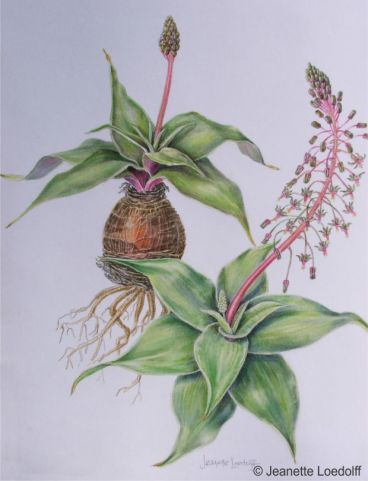
Fig. 2. Illustration of the Gouritz cliff squill, Ledebouria venteri, by Jeanette Loedolff, of a plant from Gouritzpoort near Herbertsdale, Western Cape.
Conservation Status
Status
Although assessed as Least Concern (LC) in 2009 by the Red List of South African Plants, a 2016 assesment amended its status to Rare. It is a localised habitat specialist with an extent of occurrence of 146 km², but plants are widespread along the lower Gouritz River and are not threatened.
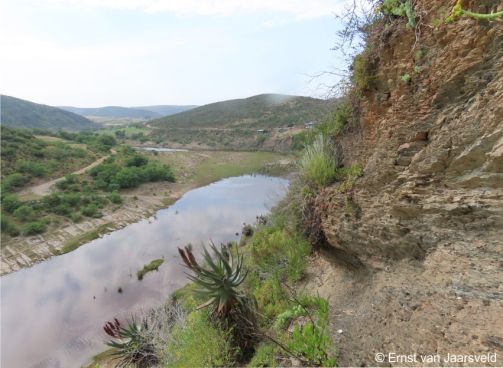
Fig. 3. The cliff-face habitat of Ledebouria venteri along the Gouritz River.
Distribution and habitat
Distribution description
Ledebouria venteri is known only from the Gouritz River between the Gouritz River Gorge (Gouritzrivierpoort) and near the Gouritz Bridge on the N2 between Albertinia and Mossel Bay in the Western Cape, where it grows on ledges of east- and west-facing cliffs and steep embankments. The Langeberg habitat consists of dry fynbos and at the confluence with the Valsrivier it grows in thicket vegetation with a high proportion of succulent plants. The geology in the Gouritz River Gorge consists of quarzitic sandstone of the Table Mountain Group (Cape Supergroup).
The Gouritz cliff squill grows at about 30 to 150 m above sea level. Plants firmly rooted in crevices, their size often depending on the growing space allowed by the crevice. Summers are hot, with temperatures up to 35°C. Winters are cooler but frost is absent. The average maximum temperature is about 24°C and average minimum about 12°C. Rainfall occurs throughout the year, ranging from 300–400 mm per annum in the form of thunder showers in summer or cyclonic winter rain.
The associated vegetation in the Gouritzrivierpoort consist of North Langeberg Sandstone Fynbos. Lower down along the Gouritzrivier it consists of Southern Cape Valley Thicket of the Albany Thicket Biome (Mucina et al. 2005).
The plants sharing the habitat of the Gouritz cliff squill at the Gouritzrivierpoort include Albuca tortuosa, Bulbine alooides, Crassula orbicularis, C. perforata and C. rupestris, Haworthia chloracantha var. chloracantha, Drimia uniflora (= Litanthus pusillus), Albuca bracteata (= Ornithogalum longibracteatum), Crassothonna cacaloides (= Othonna carnosa) and Scopelogena verruculata. Near the Gouritz Bridge ong the N2, the plants grow among Bokkeveld shale rocks (Cape Supergroup) and the associated cliff-dwelling plants include Adromischus triflorus, Cotyledon eliseae, Crassula tetragona subsp. acutifolia, Crassula lactea, Crassula orbicularis, Curio ficoides, Curio muirii, Euphorbia heptagona and Gasteria thunbergii.
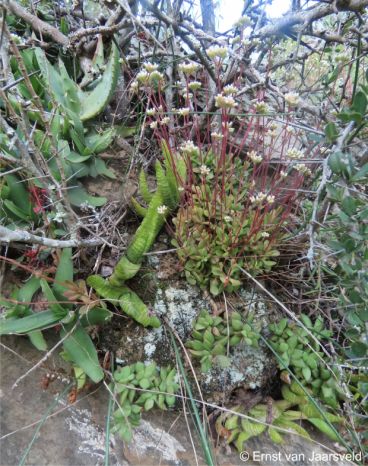
Fig. 4. Ledebouria venteri in habitat on a cliff along the Gouritz River, growing with Gasteria thunbergii, Aloe ferox, Anacampseros lanceolata and Crassula atropurpurea.
Derivation of name and historical aspects
History
Ledebouria venteri honours the intrepid botanist and ecologist Fanie Venter who has discovered numerous plant species new to science in southern Africa and abroad. Fanie revised the genus Ledebouria in 1993 for his master’s degree from the University of Natal in 1993, and which was partially published in Herbertia in 2008. The popular tree book, Making the most of indigenous trees published by Briza in 2002, was produced jointly by Fanie and his wife Julye-Ann Venter in 2002. Fanie currently resides in Christchurch, New Zealand. He is also commemorated in Coleus venteri (= Plectranthus venteri), Kleinia venteri and Euphorbia venteri.
Ledebouria venteri is related to Ledebouria concolor, the latter also grows on cliffs but is confined to the Eastern Cape. Both are evergreen, and have fleshy leaves without spots. Ledebouria venteri is a smaller species with linear-lanceolate leaves with a white, minutely denticulate margin and floral tepals that are free and fully reflexed. The flowers are also much smaller than those of Ledebouria concolor and the flower stalks, stamens and stigma are distinctly maroon-red. Ledebouria concolor, in contrast, is a much larger species, the leaves are ovate-lanceolate, with a distinctly undulating margin, and the tepals are much larger and fused at the base.
Ledebouria was named by the Swedish botanist Joran Johansson Rothman (1739-1778), a student of Linnaeus, and honours Carl Friedrich van Ledebour (1785-1851), a German-Estonian professor of botany at Tartu, Estonia (Jackson 1990, Clarke et. al. 2016).

Fig. 5. Ledebouria venteri in habitat on a shale cliff on a farm along the Gouritz River, Western Cape.
Ecology
Ecology
Plants form globose clusters, exploiting the steep to near vertical cliff-face habitat. A slow-growing fairly long-lived perennial. The fleshy bulb stores moisture which enables the plant to endure lengthy periods of drought. The spreading leaves in a rosette maximise the absorption of light. In comparison to most other Ledebouria species, the leaves are without spots, the mottled leaves provide camouflage, suggesting that this species no longer requires that adaptation, due to a lack of larger herbivores on the cliff face. The flowers are pollinated by insects, the capsules release the seeds in summer, coinciding with the rainy season, when the capsule starts to split and the small seeds are locally dispersed, ensuring the best chance of germination upon landing in a local crevice.
The plants also have a backup vegetative dispersal strategy. Plants proliferate, forming clusters that actively occupy crevices by growth and should any bulb or bulb scale become dislodged and fall onto ledges below, it will root. This is a prolific vegetative dispersal strategy ensuring long-term survival on the cliffs.
Uses
Use
No uses apart from horticultural interest have been recorded
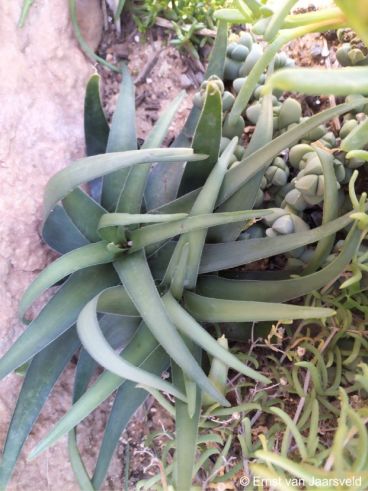
Fig. 6. The Gouritz cliff squill growing in the Richard Jamieson Thicket Garden at Babylonstoren Farm.
Growing Ledebouria venteri
Grow
Ledebouria venteri can be grown in both containers or as a garden plant in dry rockeries where frost is light. It can be grown on embankments in Thicket gardens. The plant will form clusters and is ideal for rocky pockets. It is best grown in well-drained soil with ample compost added as mulch. They can be grown in full sun or light shade.
Plants can be seen both in the succulent house and Richard Jamieson Rockery opposite the succulent house at Babylonstoren Farm.
As a pot plant, they do well in ceramic containers. Ensure good drainage using a soil mixture of 2 parts sand, 1 part garden loam and 1 part compost as a base in the container. Add ample of bonemeal. The plant will respond well to an organic fertilizer.
Propagation is by division or seed. The clusters can simply be divided and each individual planted in a container. Seed can be sown in shallow trays in a sandy mixture and covered with a thin layer of gravel or sand. Plant to the same depth as the seed is wide. Keep moist. As with many monocotyledonous plants, the seeds do not have a long life and it is best to sow them within a year of harvesting.
References
- Archer, R.H. & Carter, S. 2001. Euphorbia venteri (Euphorbiaceae). The Flowering Plants of Africa 57: t. 2176.
- Baker, J.G., in W.H.Harvey & auct. suc. (eds.). 1897. Flora Capensis; Liliaceae. 6.
- Clarke, H. & Charters, M. 2016. The illustrated dictionary of southern African plant names. Flora & Fauna Publications Trust, Jacana, Johannesburg.
- Christenhusz, M.J.M., Fay, M.F. & Chase, M.W. 2017. Plants of the World, an illustrated Encyclopedia of vascular plants. Kew Publishing, Royal Botanic Gardens, Kew.
- Germishuizen, G. & Meyer, N.L. (eds) 2003. Plants of southern Africa: an annotated checklist. Strelitzia 14. National Botanical Institute, Pretoria.
- Hankey, A.J. 2019. Proposed English common names for African hyacinths (genus Ledebouria). Plantlife SA Vol 47:7. https://plantlifesouthafrica.blogspot.com/
- Jackson, W.P.U. 1990. Origins and meanings of names of South African plant genera. University of Cape Town.
- Manning, J., Goldblatt, P. & Snijman, D. 2002. The color encyclopedia of Cape bulbs. Timber Press, Cambridge.
- Mucina, L. & Rutherford, M.C. (eds) 2006. The vegetation of South Africa, Lesotho and Swaziland. Strelitzia 19. South African National Biodiversity Institute, Pretoria.
- Van Jaarsveld, E.J. & Hankey, A. 1997. Plectranthus venteri (Lamiaceae), a new species from the Northern Province, South Africa. Aloe 34(1 & 2): 40–41.
- Van Jaarsveld, E.J. & Van Wyk, A.E. 2006. Ledebouria venteri (Hyacinthaceae), a new cliff-dwelling species from the Gouritz River, Western Cape. Aloe 43(4): 75–77.
- Van Jaarsveld, E.J. 2005. Kleinia venteri, a new succulent species from Limpopo Province (South Africa). Aloe 42(1,2): 12.
- Van Jaarsveld, E.J. 2010. Waterwise gardening in South Africa and Namibia. Struik, Cape Town.
- Venter, S. 1993. A revision of the genus Ledebouria in South Africa. M.Sc. Thesis. University of Natal, Pietermaritzburg.
- Venter, S. 2008. Synopsis of the genus Ledebouria Roth (Hyacinthaceae) in South Africa. Herbertia 62
- Von Staden, L. 2016. Ledebouria venteri Van Jaarsv. & A.E.van Wyk. National Assessment: Red List of South African Plants version 2020.1. Accessed on 2024/02/25
Credits
Ernst van Jaarsveld
Kirstenbosch National Botanical Garden (Retired)
Babylonstoren Farm (Current)
Extraordinary senior lecturer and researcher,
Department of Biodiversity and Conservation, University of the Western Cape
February 2024
Acknowledgements: the author thanks Jeanette Loedolff for preparing the illustration.
Plant Attributes:
Plant Type: Bulb
SA Distribution: Western Cape
Soil type: Loam
Flowering season: Early Summer
PH: Acid, Neutral
Flower colour: Green, Purple
Aspect: Full Sun, Shade, Morning Sun (Semi Shade), Afternoon Sun (Semi Shade)
Gardening skill: Average
Special Features:
Horticultural zones









Rate this article
Article well written and informative
Rate this plant
Is this an interesting plant?
Login to add your Comment
Back to topNot registered yet? Click here to register.